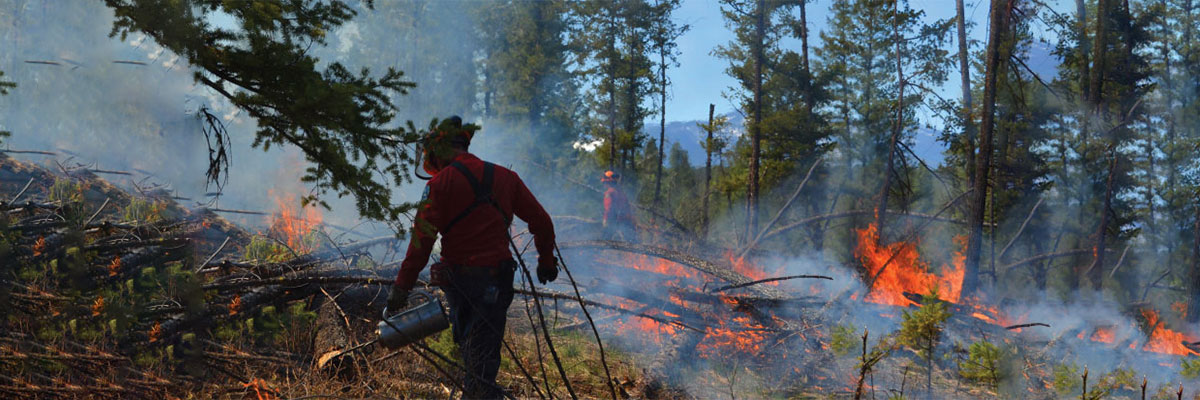Wildfires and Planned Burns ... Tidying Up The Forest
"Even if we were able to turn back the dial on climate change we would still have wildfires that are severe and would burn people's houses down.""Climate change just makes everything worse.""We're learning that by protecting our forests we're really just building a bigger bomb."Jesse Zeman, director, fish and wildlife restoration, B.C.Wildlife Federation
 |
| Vegetation and fuels management plays a vital role in wildfire prevention. One
of the best ways to mitigate wildfires in high-risk areas is to treat
the landscape ahead of time. B.C.Forests |
In Oregon ecologists spent years setting low-level fires to bolster stands of Ponderosa pines. They cleared away underbrush through localized, controlled burns which removed much of the fuel that wildfires grow on when they erupt in dry forest atmospheres. As a result of that clearing, when wildfires surged into Sycan Marsh Preserve in the state they failed to burn as widely and wildly as they might have and were easier for firefighters to control.
"Generally speaking, what firefighters were reporting on the ground is that when the fire came into those areas that had been thinned ... it had significantly less impact", explained Pete Caligiuri, one of the preserve researchers.
On Vancouver Island in British Columbia Walter Grant was one of the first settlers. He wrote complaints that "the savages have an abominable habit of burning the woods", and he persuaded upon the-then colonial government the impression that controlled burns should be banned as a condition of treaty negotiations.
Wildfire ecologist Robert Gray, based in Chilliwack B.C. at the present time has vocally advocated for increasing the number of prescribed burns in the forests of British Columbia. Typically, the province's Ministry of Forests earmarks a mere 5,000 hectares for controlled burning annually a number badly needing to reflect tens of thousands of hectares to be effective against wildfires.
 |
British Columbia began experiencing fire seasons from 2017 that were far more serious than any such events in the recorded history of wildfires in the province. That was the year 1.2 million hectares burned by wildfires;fully 40 percent higher than the previous record of 855,958 hectares that burned in 1958. Wildfires surged through 1.35 million hectares in 2018.
Last year saw a quiet wildfire season unusually when 14,000 hectares burned, the lowest in a decade. And then 2021 arrived and the wildfire season is now in competition to shatter previous records. Thanks to climate change, British Columbia was recently assailed by record-breaking heat, courtesy of a heat dome that began the 2021 fire season. Where Lytton, B.C. famously posted the highest temperature in Canadian history and hours later was rendered uninhabitable by the destruction of a follow-up wildfire.
Forests have become drier as a result of warming temperatures, the result of which has been the mountain pine beetle able to weather the winter months, their resulting numbers and appetite destroyed entire forests, turning them into flammable stands of dead trees. The severity of thunderstorms as a result of climate change saw British Columbia this summer of 2021 being hit by ten times more lightning strikes as 'normal'.
All of these incidentally vital circumstances are aided by the forests in British Columbia being sinks of "fuel load", a term used by wildfire experts represented by the presence of accumulated debris, deadwood, and untreated clearcut areas, all of which are capable of dramatically accelerating the speed and ferocity of a wildfire.
Following the fire season of 2017, an open letter was sent to B.C.Premier John Horgan by the University of B.C.'s Department of Forest & Conservation Science emphasizing that more prescribed burns were needed to curb fuel load. "In the area of fuels and forest practices, which is the largest component necessary to reduce wildfire severity and threats to communities, there has been little action", the letter read in part.
Before the presence of Europeans, many Indigenous groups practised prescribed burns by tradition in forest management to encourage the growth of edible plants and making forests easier to navigate also resulted from the practise. Now, for obvious reasons, the wisdom of Indigenous ecological practices are being recognized for their proven potential for an entirely other reason; removing the fuel on which wildfires thrive.
Wildfire ecologist Robert Gray points out that in the pre-contact era, the common practise of clearing fires affected areas no larger than 40 hectares, within forests regularly being burned. Their size and the experience Indigenous peoples acquired in controlling them meant that forests rarely acquired the fuel firestorms needed to become the ferocious beasts they now appear as. "Fire inoculated the landscape against large fires", he said.
 |
| A prescribed burn can help regenerate species of grasses and woody vegetation that are native to an area and push back the growth of non-native vegetation. (Alex Denonville/CBC) |
Labels: British Columbia. Wildfires, Climate Change, Indigenous Ecology, Planned Burns

0 Comments:
Post a Comment
<< Home